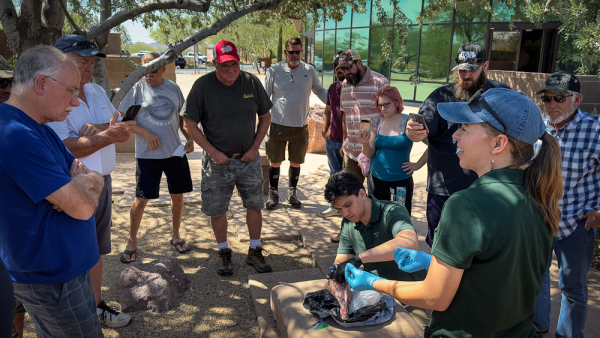Chronic Wasting Disease, more commonly referred to as just CWD, hasn’t made its way to Arizona, yet. And the Arizona Game and Fish Department (AZG&FD) is working hard to keep it that way.
Last weekend I attended one of the CWD Workshops that AZG&FD has been hosting for hunters. The workshops are designed to bring hunters up to speed on what the state is doing to combat CWD, and recruit hunters to assist with the critical effort to test harvested game.

For those unfamiliar with the disease, CWD is akin to mad cow disease in cattle. It is a neurological disease with a 100% mortality rate that is caused by a naturally occurring protein, called a prion, that becomes misfolded. This misfolded protein resists break down in the cervids – deer, elk, moose and reindeer – and causes the animal’s normal and healthy prion proteins to misfold, damaging the nervous system.
CWD is a very challenging disease to fight. First, it is easily spread. The disease is transmitted through bodily secretions, making animal-to-animal contact and contact with contaminated surfaces – think giant bait piles – the way in which it spreads through herds.
Second, an infected animal will not show signs until late in the course of the disease, meaning animals with CWD can carry and pass along the disease for several years before ever showing the first sign.
Third, and perhaps most disconcerting, is that prions cannot be destroyed with radiation or heat below 1,000 degrees Fahrenheit. In other words, hunters cannot destroy the disease through cooking the meat.
Though there has been no evidence, to date, that humans can contract CWD, public health and wildlife management officials studying the disease have found that monkeys that consume contaminated meat can contract CWD. Therefore they do not recommend the human consumption of meat from a CWD-positive animal.
So, how widespread is CWD? As of now, it has been detected in 30 states in the US, as well as five Canadian provinces, Finland, Norway, South Korea and Sweden.
Tracking CWD is difficult in that testing for the disease requires removal of the animal’s lymph nodes, in the case of deer, and the lymph nodes and obex from elk. It’s the tissue from these body parts that is used in testing for the disease.
Which is why Arizona Game and Fish Department officials are conducting workshops throughout the Grand Canyon State to help hunters better understand the important role they play in aiding in the testing process, and teach them how to collect the needed parts for testing.
During the workshop led by Dr. Katie Schwartz, Assistant Wildlife Veterinarian for AZG&FD, she noted that Arizona started collecting and testing samples from harvested animals in 1998. Since then Arizona has collected over 30,000 samples.
Right now the bulk of those samples come from Arizona’s meat processors and taxidermists who work closely with state officials to help monitor for CWD. Through the workshops, and teaching hunters the correct way to collect the lymph node and obex samples, officials hope to meet, and maybe exceed, their seasonal goal of 1,500 sampled animals. As well as increase collections in the high priority game management units.

Arizona’s focused efforts on monitoring are just one aspect of overall fight against CWD. Over the years the Arizona has passed regulations to address the CWD threat to the state’s cervids. Cervid farms, an area of CWD spread in other states, have been banned in Arizona. Additionally, the use of bait piles has been banned and the use of cervid urine attractants have been outlawed.
And because prions aren’t remotely easy to destroy, the transportation of deer, elk and other cervid meat and tissue into Arizona is highly regulated. This is true for many states wishing to stave off CWD, or mitigate the spread of CWD within their state.
Arizona’s success in holding off CWD is due in part to its geography. Dr. Schwartz told me that due to the fact we have no big migrations in Arizona, and a lower density of animals, the state has been able to remain CWD free.
However, with CWD now present in Utah, Colorado and New Mexico, the states bordering Arizona to the north, northeast and west respectively, the threat of CWD crossing the borders into Arizona is mounting.
Despite the best efforts of Dr. Schwartz and her AZG&FD colleagues, and Arizona’s sportsmen and women working to assist in the fight against CWD, there is one thing that cannot be stopped, and that’s Mother Nature.
Unfortunately for Arizona and those combating CWD, Mother Nature is undefeated.
— Paul Erhardt, Managing Editor, the Outdoor Wire Digital Network